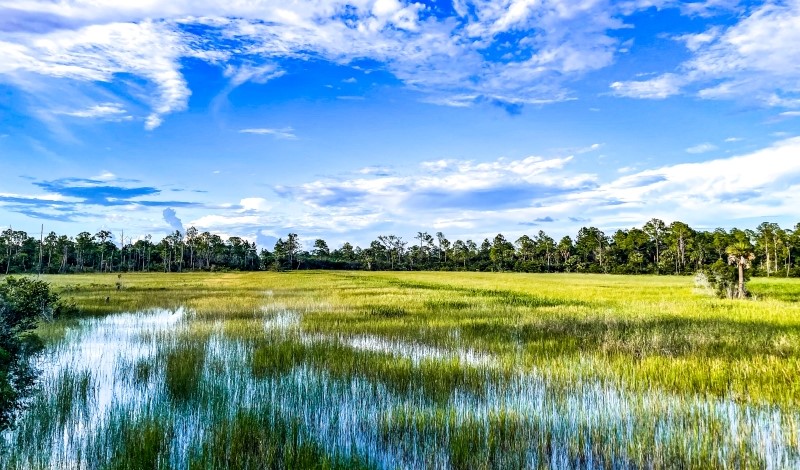
New joint agency report recommends nature-based solutions to protect frontline communities from climate risks.
Climate change today fuels record wildfire seasons and exacerbates the severity of tropical storms. These natural disasters not only destroy critical infrastructure, but they also endanger communities. As a result, President Joseph R. Biden has called tackling climate change the greatest challenge facing our country today.
Policymakers, though, have largely overlooked one powerful source of climate solutions: nature. But what exactly counts as a nature-based solution? The Federal Emergency Management Agency defines these actions as sustainable planning, design, environmental management, and engineering practices that weave natural features or processes into the built environment to promote climate adaptation or resilience.
To address policymakers’ oversight, President Biden on Earth Day 2022 announced in Executive Order 14072 that he would prioritize the use of nature-based solutions to fight climate change. The executive order directed several agencies to work together to identify key opportunities to facilitate the development and deployment of nature-based conservation strategies.
Drawing on this joint agency effort, a recent government report details five major steps that federal agencies can take to scale up their use of nature-based solutions nationwide. Implementing these five recommended steps is intended to enable federal agencies to unlock the full potential of nature-based solutions.
First, the report urges agencies to revise their planning, decision-making, and cost-sharing frameworks to include nature-based solutions. Specifically, it identifies federal permitting and reviews as a key area for building interagency coordination. The report also advocates that agencies review their existing risk-management processes and benefit-cost analyses to account for the use of nature-based solutions. Decisionmakers in coastal communities, for example, weigh alternatives for storm hazard mitigation frequently. Standards-setting agencies, such as the National Institute of Standards and Technology, can assist frontline communities by integrating nature-based solutions into their toolkits and planning protocols.
Second, agencies can unlock access to existing federal funds by increasing coordination and streamlining funding application processes. The report outlines a two-step approach to channel funding processes: first integrate nature-based solutions into existing domestic and international funding programs, then prioritize use of those solutions in funding decisions. Public-private partnerships, too, may play a role. The report emphasizes the need both to ease access to government funding and to catalyze private investment.
Third, the report recommends that agencies adopt existing best practices around natural resource management. The report calls on agencies with large land holdings, such as the U.S. Department of the Interior, to include nature-based solutions in their planning and land management strategies. The report also directs agencies to engage with Tribal Nations in co-stewardship and co-management of natural resources. In theory, federal-tribal partnerships not only build resilience, they also contribute to righting injustice by returning management of ancestral lands to Tribal Nations.
Fourth, agency programs can expedite the development of a skilled domestic workforce. Many professions support the deployment and maintenance of nature-based climate solutions, including community planning, ecology, engineering, and law. Through targeted agency partnerships, such as a joint initiative between the U.S. Army Corps of Engineers and the University of Georgia focused on “Engineering With Nature,” the federal government can support technical training programs. Agencies also can provide tools, such as updated flood risk maps, to bolster existing community planning efforts.
Finally, the report urges federal agencies to prioritize identifying—and then filling—gaps in the existing understanding of nature-based solutions. To do so, the report recommends that agencies offer grants, prizes, and challenges to galvanize research and development efforts at academic and non-profit institutions. The report also suggests that agencies employ adaptive learning to make evidence-based decisions about how conservation methods can be improved.
Implementing these recommendations will not be easy. Stakeholders identified obstacles that may frustrate attempts to scale-up nature-based solutions. Lack of awareness of when nature-based solutions can address social and economic challenges, for example, remains a core barrier to their use.
The report also explains that, although nature-based solutions can help address common problems, such as the urban heat island effect or coastal flooding, current policies and regulations are not designed to promote these options.
Regulatory accounting poses a challenge, too. Benefit-cost analysis frameworks that apply high discount rates work to disadvantage projects that yield long-term benefits, including many nature-based solutions, over alternative projects that offer near-term benefits.
These challenges, however, are not insurmountable, according to the report. By leveraging the collective expertise of several federal agencies—led by the White House Council on Environmental Quality, the White House Office of Domestic Climate Policy, and the White House Office of Science and Technology Policy—the Biden Administration can use government resources to advance and support nature-based solutions nationally.
Furthermore, the report notes that the federal government can look to local success stories for guidance. Local communities have long pursued best practices for managing the natural resources that they rely on, such as forests and wetlands. Native American communities, in particular, pioneered responsible land management practices. The federal government can support historic Tribal conservation practices, such as controlled burns of forested areas, to promote broader use of nature-based solutions.
Pursuing an all-of-the-above strategy to fight climate change could not be more critical. Communities are racing both to adapt to present impacts of climate change and to mitigate future climate risks. Nature-based solutions can support both goals, according to the report.



